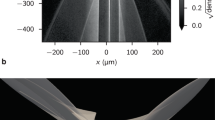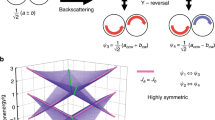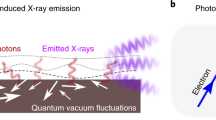Abstract
Optical microcavities confine light to small volumes by resonant recirculation. Devices based on optical microcavities are already indispensable for a wide range of applications and studies. For example, microcavities made of active III–V semiconductor materials control laser emission spectra to enable long-distance transmission of data over optical fibres; they also ensure narrow spot-size laser read/write beams in CD and DVD players. In quantum optical devices, microcavities can coax atoms or quantum dots to emit spontaneous photons in a desired direction or can provide an environment where dissipative mechanisms such as spontaneous emission are overcome so that quantum entanglement of radiation and matter is possible. Applications of these remarkable devices are as diverse as their geometrical and resonant properties.
This is a preview of subscription content, access via your institution
Access options
Subscribe to this journal
Receive 51 print issues and online access
$199.00 per year
only $3.90 per issue
Buy this article
- Purchase on Springer Link
- Instant access to full article PDF
Prices may be subject to local taxes which are calculated during checkout






Similar content being viewed by others
References
Gerard, J. M. et al. Quantum boxes as active probes for photonic microstructures: The pillar microcavity case. Appl. Phys. Lett. 69, 449–451 (1996).
Solomon, G. S., Pelton, M. & Yamamoto, Y. Modification of spontaneous emission of a single quantum dot. Phys. Status Solidi 178, 341–344 (2000).
Jewell, J. L. et al. Lasing characteristics of GaAs microresonators. Appl. Phys. Lett. 54, 1400–1402 (1989).
Chang, R. K. (ed.) Optical Processes in Microcavities (World Scientific, Singapore, 1996).
Rayleigh, L. in Scientific Papers 617–620 (Cambridge Univ., Cambridge, 1912).
Armani, D. K., Kippenberg, T. J., Spillane, S. M. & Vahala, K. J. Ultra-high-Q toroid microcavity on a chip. Nature 421, 925–928 (2003).
Painter, O. et al. Two-dimensional photonic band-gap defect mode laser. Science 284, 1819–1821 (1999).
Taranenko, V. B. & Weiss, C. O. Spatial solitons in semiconductor microresonators. IEEE J. Select. Top. Quantum Elect. 8, 488–496 (2002).
Barland, S. et al. Cavity solitons as pixels in semiconductor microcavities. Nature 419, 699–702 (2002).
Stone, A. D. Wave-chaotic optical resonators and lasers. Physica Scripta T90, 248–262 (2001).
Khitrova, G., Gibbs, H. M., Jahnke, F., Kira, M. & Koch, S. W. Nonlinear optics of normal-mode-coupling semiconductor microcavities. Rev. Mod. Phys. 71, 1591–1639 (1999).
Brinkman, W. F., Koch, T. L., Lang, D. V. & Wilt, D. P. The lasers behind the communications revolution. Bell Labs Tech. J. 5, 150–167 (2000).
Coldren, L. A. & Corzine, S. W. Diode Lasers and Photonic Integrated Circuits (Wiley, New York, 1995).
Yariv, A. Quantum Electronics (Wiley, New York, 1989).
Berman, P. R. (ed.) Cavity Quantum Electrodynamics (Academic Press, New York, 1993).
Haroche, S. Entanglement, mesoscopic superpositions and decoherence studies with atoms and photons in a cavity. Physica Scripta T76, 159–164 (1998).
Kimble, H. J. Strong interactions of single atoms and photons in cavity QED. Physica Scripta T76, 127–137 (1998).
Thompson, R. J., Rempe, G. & Kimble, H. J. Observation of normal-mode splitting for an atom in an optical cavity. Phys. Rev. Lett. 68, 1132–1135 (1992).
Mabuchi, H., Turchette, Q. A., Chapman, M. S. & Kimble, H. J. Real-time detection of individual atoms falling through a high- finesse optical cavity. Opt. Lett. 21, 1393–1395 (1996).
Rempe, G. One-atom in an optical cavity – spatial-resolution beyond the standard diffraction limit. Appl. Phys. B 60, 233–237 (1995).
Hood, C. J., Lynn, T. W., Doherty, A. C., Parkins, A. S. & Kimble, H. J. The atom-cavity microscope: Single atoms bound in orbit by single photons. Science 287, 1447–1453 (2000).
Pinkse, P. W. H., Fischer, T., Maunz, P. & Rempe, G. Trapping an atom with single photons. Nature 404, 365–368 (2000).
Shimizu, Y. et al. Control of light pulse propagation with only a few cold atoms in a high-finesse microcavity. Phys. Rev. Lett. 89, 233001 (2002).
Mabuchi, H. & Doherty, A. C. Cavity quantum electrodynamics: Coherence in context. Science 298, 1372–1377 (2002).
Raimond, J. M., Brune, M. & Haroche, S. Colloquium: Manipulating quantum entanglement with atoms and photons in a cavity. Rev. Mod. Phys. 73, 565–582 (2001).
Rempe, G., Thompson, R. J., Kimble, H. J. & Lalezari, R. Measurement of ultralow losses in an optical interferometer. Opt. Lett. 17, 363–365 (1992).
LefevreSeguin, V. & Haroche, S. Towards cavity-QED experiments with silica microspheres. Mat. Sci. Eng. B 48, 53–58 (1997).
Gorodetsky, M. L., Savchenkov, A. A. & Ilchenko, V. S. Ultimate Q of optical microsphere resonators. Opt. Lett. 21, 453–455 (1996).
Vernooy, D. W., Ilchenko, V. S., Mabuchi, H., Streed, E. W. & Kimble, H. J. High-Q measurements of fused-silica microspheres in the near infrared. Opt. Lett. 23, 247–249 (1998).
Vuckovic, J., Loncar, M., Mabuchi, H. & Scherer, A. Design of photonic crystal microcavities for cavity QED. Phys. Rev. E 6501, 016608 (2002).
Buck, J. R. and Kimble, H. J. Optimal sizes of dielectric microspheres for cavity QED with strong coupling. Phys. Rev. A 033806 (2003).
Hood, C. J., Kimble, H. J. & Ye, J. Characterization of high-finesse mirrors: Loss, phase shifts, and mode structure in an optical cavity. Phys. Rev. A 6403, 033804 (2001).
Knight, J. C. et al. Mapping whispering-gallery modes in microspheres with a near-field probe. Opt. Lett. 20, 1515–1517 (1995).
Vernooy, D. W., Furusawa, A., Georgiades, N. P., Ilchenko, V. S. & Kimble, H. J. Cavity QED with high-Q whispering gallery modes. Phys. Rev. A 57, R2293–R2296 (1998).
Braginsky, V. B., Gorodetsky, M. L. & Ilchenko, V. S. Quality-factor and nonlinear properties of optical whispering-gallery modes. Phys. Lett. A 137, 393–397 (1989).
Gorodetsky, M. L. & Ilchenko, V. S. Optical microsphere resonators: optimal coupling to high-Q whispering-gallery modes. J. Opt. Soc. Am. B 16, 147–154 (1999).
Ilchenko, V. S., Yao, X. S. & Maleki, L. Pigtailing the high-Q microsphere cavity: a simple fiber coupler for optical whispering-gallery modes. Opt. Lett. 24, 723–725 (1999).
Treussart, F. et al. Microlasers based on silica microspheres. Ann. Telecommun. 52, 557–568 (1997).
Serpenguzel, A., Arnold, S. & Griffel, G. Excitation of resonances of microspheres on an optical fiber. Opt. Lett. 20, 654–656 (1995).
Knight, J. C., Cheung, G., Jacques, F. & Birks, T. A. Phase-matched excitation of whispering-gallery-mode resonances by a fiber taper. Opt. Lett. 22, 1129–1131 (1997).
Cirac, J. I., van Enk, S. J., Zoller, P., Kimble, H. J. & Mabuchi, H. Quantum communication in a quantum network. Physica Scripta T76, 223–232 (1998).
Cai, M., Painter, O. & Vahala, K. J. Observation of critical coupling in a fiber taper to a silica-microsphere whispering-gallery mode system. Phys. Rev. Lett. 85, 74–77 (2000).
Spillane, S. M., Kippenberg, T. J. & Vahala, K. J. Ultralow-threshold Raman laser using a spherical dielectric microcavity. Nature 415, 621–623 (2002).
Purcell, E. M. Spontaneous emission probabilities at radio frequencies. Phys. Rev. 69, 681–681 (1946).
Yamamoto, Y., Tassone, F. & Cao, H. Semiconductor Cavity Quantum Electrodynamics (Springer, New York, 2000).
Haroche, S. & Kleppner, D. Cavity quantum electrodynamics. Phys. Today 42, 24–30 (1989).
Marzin, J. Y., Gerard, J. M., Izrael, A., Barrier, D. & Bastard, G. Photoluminescence of single Inas quantum dots obtained by self-organized growth on GaAs. Phys. Rev. Lett. 73, 716–719 (1994).
Gerard, J. M. et al. Enhanced spontaneous emission by quantum boxes in a monolithic optical microcavity. Phys. Rev. Lett. 81, 1110–1113 (1998).
Gerard, J. M. & Gayral, B. InAs quantum dots: artificial atoms for solid-state cavity- quantum electrodynamics. Physica E 9, 131–139 (2001).
Gerard, J. M. et al. InAs quantum boxes in GaAs/AlAs pillar microcavities: From spectroscopic investigations to spontaneous emission control. Physica E 2, 804–808 (1998).
Bayer, M. et al. Inhibition and enhancement of the spontaneous emission of quantum dots in structured microresonators. Phys. Rev. Lett. 86, 3168–3171 (2001).
Gayral, B. et al. High-Q wet-etched GaAs microdisks containing InAs quantum boxes. Appl. Phys. Lett. 75, 1908–1910 (1999).
Michler, P. et al. Quantum dot lasers using high-Q microdisk cavities. Phys. Status Solidi B 224, 797–801 (2001).
Kiraz, A. et al. Cavity-quantum electrodynamics using a single InAs quantum dot in a microdisk structure. Applied Phys. Lett. 78, 3932–3934 (2001).
Gerard, J. M. & Gayral, B. Strong Purcell effect for InAs quantum boxes in three-dimensional solid-state microcavities. J. Lightwave Tech. 17, 2089–2095 (1999).
Pelton, M., Vuckovic, J., Solomon, G. S., Scherer, A. & Yamamoto, Y. Three-dimensionally confined modes in micropost microcavities: Quality factors and Purcell factors. IEEE J. Quantum Elect. 38, 170–177 (2002).
Vuckovic, J., Pelton, M., Scherer, A. & Yamamoto, Y. Optimization of three-dimensional micropost microcavities for cavity quantum electrodynamics. Phys. Rev. A 66, 023808 (2002).
Yablonovitch, E. Inhibited spontaneous emission in solid-state physics and electronics. Phys. Rev. Lett. 58, 2059–2062 (1987).
Reese, C. et al. High-Q photonic crystal microcavities fabricated in a thin GaAs membrane. J. Vac. Sci. Technol. B 19, 2749–2752 (2001).
Happ, T. D. et al. Enhanced light emission of InxGa1-xAs quantum dots in a two- dimensional photonic-crystal defect microcavity. Phys. Rev. B 66, 041303 (2002).
Srinivasan, K. & Painter, O. Momentum space design of high-Q photonic crystal optical cavities. Opt. Exp. 10, 670–684 (2002).
Srinivasan, K., Barclay, P., Painter, O., Chen, J., Cho, C. & Gmachl, C. Experimental demonstration of a high quality factor photonic crystal microcavity. Appl. Phys. Lett. (in the press).
Boroditsky, M. et al. Spontaneous emission extraction and Purcell enhancement from thin-film 2-D photonic crystals. J. Lightwave Technol. 17, 2096–2112 (1999).
D. Bouwmeester, A. E. & A. Zeilinger. The Physics of Quantum Information (Springer, Berlin, 2000).
Kimble, H. J., Dagenais, M. & Mandel, L. Photon anti-bunching in resonance fluorescence. Phys. Rev. Lett. 39, 691–695 (1977).
Basche, T., Moerner, W. E., Orrit, M. & Talon, H. Photon antibunching in the fluorescence of a single dye molecule trapped in a solid. Phys. Rev. Lett. 69, 1516–1519 (1992).
Michler, P. et al. Quantum correlation among photons from a single quantum dot at room temperature. Nature 406, 968–970 (2000).
Michler, P. et al. A quantum dot single-photon turnstile device. Science 290, 2282–2285 (2000).
Santori, C., Pelton, M., Solomon, G., Dale, Y. & Yamamoto, E. Triggered single photons from a quantum dot. Phys. Rev. Lett. 86, 1502–1505 (2001).
Zwiller, V. et al. Single quantum dots emit single photons at a time: Antibunching experiments. Appl. Phys. Lett. 78, 2476–2478 (2001).
Thompson, R. M. et al. Single-photon emission from exciton complexes in individual quantum dots. Phys. Rev. B 64, 201302 (2001).
Lounis, B. & Moerner, W. E. Single photons on demand from a single molecule at room temperature. Nature 407, 491–493 (2000).
Brunel, C., Lounis, B., Tamarat, P. & Orrit, M. Triggered source of single photons based on controlled single molecule fluorescence. Phys. Rev. Lett. 83, 2722–2725 (1999).
Moreau, E. et al. Single-mode solid-state single photon source based on isolated quantum dots in pillar microcavities. Appl. Phys. Lett. 79, 2865–2867 (2001).
Santori, C., Fattal, D., Vuckovic, J., Solomon, G. S. & Yamamoto, Y. Indistinguishable photons from a single-photon device. Nature 419, 594–597 (2002).
Pelton, M. et al. Efficient source of single photons: A single quantum dot in a micropost microcavity. Phys. Rev. Lett. 89, 233602 (2002).
Yuan, Z. L. et al. Electrically driven single-photon source. Science 295, 102–105 (2002).
Qian, S. X., Snow, J. B., Tzeng, H. M. & Chang, R. K. Lasing droplets – highlighting the liquid-air interface by laser-emission. Science 231, 486–488 (1986).
Lin, H. B., Eversole, J. D. & Campillo, A. J. Spectral properties of lasing microdroplets. J. Opt. Soc. Am. B 9, 43–50 (1992).
Cai, M., Painter, O., Vahala, K. J. & Sercel, P. C. Fiber-coupled microsphere laser. Opt. Lett. 25, 1430–1432 (2000).
Kuwatagonokami, M., Takeda, K., Yasuda, H. & Ema, K. Laser-emission from dye-doped polystyrene microsphere. Japanese J. Appl. Phys. 2 31, L99–L101 (1992).
McCall, S. L., Levi, A. F. J., Slusher, R. E., Pearton, S. J. & Logan, R. A. Whispering-gallery mode microdisk lasers. Appl. Phys. Lett. 60, 289–291 (1992).
Rex, N. B., Chang, R. K. & Guido, L. J. Threshold lowering in GaN micropillar lasers by means of spatially selective optical pumping. IEEE Phot. Technol. Lett. 13, 1–3 (2001).
Deppe, D. G., Huffaker, D. L., Oh, T. H., Deng, H. Y. & Deng, Q. Low-threshold vertical-cavity surface-emitting lasers based on oxide-confinement and high contrast distributed Bragg reflectors. IEEE J. Select. Top. Quantum Elect. 3, 893–904 (1997).
Sandoghdar, V. et al. Very low threshold whispering-gallery-mode microsphere laser. Phys. Rev. A 54, R1777–R1780 (1996).
Macdougal, M. H., Dapkus, P. D., Pudikov, V., Zhao, H. M. & Yang, G. M. Ultralow threshold current vertical-cavity surface-emitting lasers with AlAs oxide-GaAs Distributed Bragg reflectors. IEEE Phot. Technol. Lett. 7, 229–231 (1995).
Huffaker, D. L., Graham, L. A., Deng, H. & Deppe, D. G. Sub-40 microAmp continuous-wave lasing in an oxidized vertical-cavity surface-emitting laser with dielectric mirrors. IEEE Phot. Technol. Lett. 8, 974–976 (1996).
Yamamoto, Y. & Slusher, R. E. Optical processes in microcavities. Phys. Today 46, 66–73 (1993).
Rice, P. R. & Carmichael, H. J. Photon statistics of a cavity-QED laser – a comment on the laser-phase-transition analogy. Phys. Rev. A 50, 4318–4329 (1994).
An, K. & Feld, M. A. Semiclassical four-level single atom laser. Phys. Rev. A 56, 1662–1665 (1997).
Graham, L. A., Huffaker, D. L., Csutak, S. M., Deng, Q. & Deppe, D. G. Spontaneous lifetime control of quantum dot emitters in apertured microcavities. J. Appl. Phys. 85, 3383–3385 (1999).
Qian, S. X., Snow, J. B. & Chang, R. K. Coherent Raman mixing and coherent anti-Stokes Raman-scattering from individual micrometer-size droplets. Opt. Lett. 10, 499–501 (1985).
Lin, H. B., Eversole, J. D. & Campillo, A. J. Continuous-wave stimulated Raman-scattering in microdroplets. Opt. Lett. 17, 828–830 (1992).
Qian, S. X. & Chang, R. K. Multiorder Stokes emission from micrometer-size droplets. Phys. Rev. Lett. 56, 926–929 (1986).
Zhang, J. Z., Chen, G. & Chang, R. K. Pumping of stimulated Raman-scattering by stimulated Brillouin-scattering within a single liquid droplet – input laser linewidth effects. J. Opt. Soc. Am. B 7, 108–115 (1990).
Treussart, F. et al. Evidence for intrinsic Kerr bistability of high-Q microsphere resonators in superfluid helium. Eur. Phys. J. D 1, 235–238 (1998).
Kaminow, I. P. & San, T. L. (eds) Optical Fiber Telecommunications IV (Academic Press, San Diego, 2002).
Alexander, S. B. et al. A precompetitive consortium on wide-band all-optical networks. J. Lightwave Technol. 11, 714–735 (1993).
Hibino, Y., Maruno, T. & Okamoto, K. Recent progress on large-scale PLC technologies with advanced functions. NTT Review 13, 4–9 (2001).
Kewitsch, A. S., Rakuljic, G. A., Willems, P. A. & Yariv, A. All-fiber zero-insertion-loss add-drop filter for wavelength- division multiplexing. Opt. Lett. 23, 106–108 (1998).
Doerr, C. R. et al. 40-wavelength add-drop filter. IEEE Phot. Technol. Lett. 11, 1437–1439 (1999).
Suzuki, S., Hatakeyama, Y., Kokubun, Y. & Chu, S. T. Precise control of wavelength channel spacing of microring resonator add-drop filter array. J. Lightwave Technol. 20, 745–750 (2002).
Djordjev, K., Choi, S. J. & Dapkus, P. D. Microdisk tunable resonant filters and switches. IEEE Phot. Technol. Lett. 14, 828–830 (2002).
Rabiei, P. Steier, W. H., Cheng Zhang and Dalton, L. R. Polymer micro-ring filters and modulators. J. Lightwave Technol. 20, 1968–1975 (2002).
Little, B. E. et al. Wavelength switching and routing using absorption and resonance. IEEE Phot. Technol. Lett. 10, 816–818 (1998).
Djordjev, K., Choi, S. J. & Dapkus, P. D. Vertically coupled InP microdisk switching devices with electroabsorptive active regions. IEEE Phot. Technol. Lett. 14, 1115–1117 (2002).
Yariv, A. Critical coupling and its control in optical waveguide-ring resonator systems. IEEE Phot. Technol. Lett. 14, 483–485 (2002).
Soref, R. A. & Little, B. E. Proposed N-wavelength M-fiber WDM crossconnect switch using active microring resonators. IEEE Phot. Technol. Lett. 10, 1121–1123 (1998).
Chu, S. T. et al. An eight-channel add-drop filter using vertically coupled microring resonators over a cross grid. IEEE Phot. Technol. Lett. 11, 691–693 (1999).
Grover, R. et al. Vertically coupled GaInAsP-InP microring resonators. Opt. Lett. 26, 506–508 (2001).
Little, B. E. et al. Vertically coupled glass microring resonator channel dropping filters. IEEE Phot. Technol. Lett. 11, 215–217 (1999).
Offrein, B. J. et al. Resonant coupler-based tunable add-after-drop filter in silicon-oxynitride technology for WDM networks. IEEE J. Select. Top. Quantum Elect. 5, 1400–1406 (1999).
Little, B. E., Chu, S. T., Haus, H. A., Foresi, J. & Laine, J. P. Microring resonator channel dropping filters. J. Lightwave Technol. 15, 998–1005 (1997).
Grover, R. et al. Parallel-cascaded semiconductor microring resonators for high- order and wide-FSR filters. J. Lightwave Technol. 20, 872–877 (2002).
Yanagase, Y., Suzuki, S., Kokubun, Y. & Chu, S. T. Box-like filter response and expansion of FSR by a vertically triple coupled microring resonator filter. J. Lightwave Technol. 20, 1525–1529 (2002).
Cooper, M. A. Optical biosensors in drug discovery. Nat. Rev. Drug Discov. 1, 515–527 (2002).
Marazuela, M. D. & Moreno-Bondi, M. C. Fiber-optic biosensors – an overview. Anal. Bioanal. Chem. 372, 664–682 (2002).
Krioukov, E., Klunder, D. J. W., Driessen, A., Greve, J. & Otto, C. Sensor based on an integrated optical microcavity. Opt. Lett. 27, 512–514 (2002).
Vollmer, F. et al. Protein detection by optical shift of a resonant microcavity. Appl. Phys. Lett. 80, 4057–4059 (2002).
Walther, H. Quantum optics of a single atom. Physica Scripta 1, 138–146 (1998)
Acknowledgements
This work was supported by DARPA, the Caltech Lee Centre and the National Science Foundation.
Author information
Authors and Affiliations
Rights and permissions
About this article
Cite this article
Vahala, K. Optical microcavities. Nature 424, 839–846 (2003). https://doi.org/10.1038/nature01939
Issue Date:
DOI: https://doi.org/10.1038/nature01939
This article is cited by
-
Efficient side-coupling configuration for photonic crystal nanobeam cavities with micro-ring resonators
Optical and Quantum Electronics (2024)
-
A Review of a Spectral Domain Interferometer with a Frequency Comb for Length Measurement
International Journal of Precision Engineering and Manufacturing (2024)
-
Entanglement generation by strong coupling between surface lattice resonance and exciton in an Al nanoarray-coated WS2 quantum emitter
Discover Nano (2023)
-
Phonon-assisted upconversion in twisted two-dimensional semiconductors
Light: Science & Applications (2023)
-
Applications of bound states in the continuum in photonics
Nature Reviews Physics (2023)
Comments
By submitting a comment you agree to abide by our Terms and Community Guidelines. If you find something abusive or that does not comply with our terms or guidelines please flag it as inappropriate.



